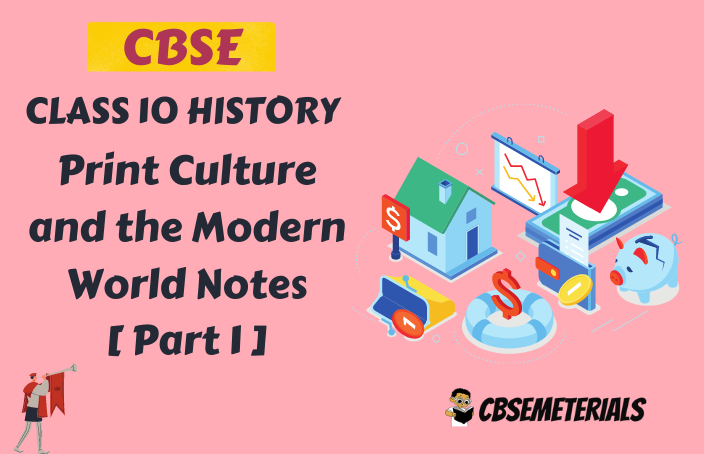Hello Guys My Name is Ayan From CBSEMeterials – Free CBSE Study Meterials and Today I am going to share The Making of a Global World Class 10 Notes [Part 2] For Free and Which Helps you in Getting Good Marks in CBSE Class 10 History Chapter 3 Summary .You can also download The Making of a Global World Class 10 Notes PDF For Free of Cost. So without further ado, let’s get to the Class 10 Summary of The Making of a Global World Class 10 Notes [Part 2]
Contents
hide
Other Parts of The Making of a Global World
Quick Review of The Making of a Global World Class 10 Notes
- The First World War (1914–18) was fought mostly in Europe, but due to global economic and political instability, its effects were felt everywhere.
- This war was the first industrial war in modern times. It witnessed the widespread use of machine guns, tanks, aeroplanes, chemical weapons etc.
- The majority of those murdered and maimed were males of working age, which resulted in a decrease in the number of people in Europe who were physically able to work.
- Britain borrowed a sizable sum of money from US institutions and the general population, turning the US from a global debtor to a global creditor.
- Prior to World War II, Britain had the largest economy in the planet, but it was forced to endure a protracted crisis. Industries had grown in Japan and India in the meanwhile.
- Following the war, Britain struggled to compete internationally with Japan and regain its former position of market supremacy in India.
- There had been a significant increase in demand, production, and employment as a result of the conflict.
- Eastern Europe was a significant global producer of wheat prior to the war, but due to disruptions in its supply, wheat output in Canada, America, and Australia significantly increased.
- Mass production was a significant aspect of the 1920s US economy. Henry Ford, a well-known manufacturer of automobiles, was a mass production pioneer.
- The first mass-produced vehicle was a Ford T-Model.
- There was a rise in the purchasing of refrigerators, washing machines, radios, and record players through a system of “hire buy” as mass production brought down costs and prices of technical goods.
- A cycle of increased employment and incomes, greater consumption demand, more investment, and still more employment and incomes appeared to be produced by significant investments in housing and household goods.
- The Great Depression of 1929 began to spread over the world by 1929.
- During this time, output, employment, incomes, and commerce fell drastically in the majority of the world’s countries.
- A number of factors related to agricultural overproduction contributed to the downturn.
- Loans from the US helped many nations finance their investments. Much of the rest of the globe was impacted by the US loans being withdrawn.
- In response to the price decline and the possibility of a depression, US banks likewise reduced domestic lending and called loans.
- More long-lasting were the impacts of the Great Depression on society, politics, international relations, and people’s brains.
- The downturn immediately damaged Indian trade since colonial India had evolved into an exporter of agricultural products and an importer of manufactured goods.
- The founding of the Bretton Woods conference:
- The IMF to address the external surpluses and deficits of its member countries
- The World Bank, also known as the International Bank for Reconstruction and Development, was established to provide funding for post-war reconstruction.
- By “NIEO,” they meant a system that would give them actual sovereignty over their natural resources, more support for international development, more equitable prices for raw materials, and better access for their produced goods to markets in richer nations.
- Unemployment in the industrialised world increased starting in the middle of the 1970s and stayed high until the early 1990s.
- MNCs started moving production to low-wage Asian nations starting in the late 1970s, including China.
- Foreign multinational corporations (MNCs) vying for global market share found China to be a desirable location for investment.
- Industry migration to low-wage nations boosted international trade and capital flows.]
Nationalism in India Notes
- [ Part 1] Nationalism in India Class 10 Notes
- [ Part 2] Nationalism in India Class 10 Notes
- [ Part 3] Nationalism in India Class 10 Notes
Flowchart of The Making of a Global World Class 10 Notes PDF
![[Part 2] The Making of a Global World Class 10 Notes | The Making of a Global World Class 10 Notes PDF 1 Flowchart of The Making of a Global World Class 10 Notes PDF](https://www.cbsemeterials.com/wp-content/uploads/2022/11/Screenshot_1-7.png)
Important Terms of The Making of a Global World Class 10 Notes [Part 2]
- Industrial War : The use of machine guns, tanks, aeroplanes, chemical weapons, and other economic practises involving the processing of raw resources and the production of goods in factories, such as the Industrial War.
- Henry Ford : Henry Ford was a well-known innovator in the mass manufacturing of automobiles.
- Hire Purchase: A method of buying something and paying for it in recurring payments while using it.
- The Great Depression : He Great Depression was a global economic downturn that lasted from 1929 to 1939 and was marked by widespread poverty and huge unemployment.
- Bank Loan: A sum of money that a bank lends to a borrower at interest, typically in exchange for collateral security, for a set length of time.
- Allies: Before the First World War, Britain, France, and Russia formed an alliance. The United States eventually joined them, and they fought together in the conflict.
- Central Powers : During the First World War, Germany, Austria, Hungary, and Ottoman Turkey established an alliance known as the Central Powers.
- Axis Powers: During the Second World War, Germany, Italy, and Japan were referred to as Axis Powers.
- El Dorado : El Dorado, the mythical “city of gold,”
- Exchange Rates : For the purpose of international trade, exchange rates link different national currencies. Fixed exchange rates and floating exchange rates are the two main categories of exchange rates.
- Fixed exchange rates: Rates that are set by the government and are not affected by fluctuations in the supply and demand of foreign currency.
- Flexible or floating exchange rates: These rates alter according to the supply and demand for foreign currencies on foreign exchange markets, generally free from government control.
- Tariff: A charge placed on a nation’s imports from abroad. At the point of entrance, such as the border or the airport, taxes are imposed.
- Hosay: A wild carnival in Trinidad held in honour of Imam Hussain, attended by workers of all colours and beliefs.
- Plantation: A place where cash crops like sugarcane, cotton, tobacco, tea, and coffee are grown.
- MNCs : Multinational Corporations (MNCs) are significant businesses that simultaneously conduct business in a number of different nations.
- IMF: The Bretton Woods institution is also known as the International Monetary Fund. It was created to address the external surpluses and deficits of the countries that make up its membership.
- IBRD : The International Bank for Reconstruction and Development, also referred to as the World Bank, is referred to as IBRD. It was created to provide funding for post-war development.
- The G-77: Often known as the Group of 77, is a group of seventy-seven developing nations that missed out on the 1950s and 1960s fast expansion of the western economies.
The Rise Of Nationalism In Europe Notes
- [ Part 1] The Rise Of Nationalism In Europe Class 10 Notes
- [ Part 3] The Rise of Nationalism in Europe Class 10 Notes
- [Part 2] The Rise of Nationalism in Europe Class 10 Notes
Important Dates of Terms of The Making of a Global World Class 10 Notes
- 1914-1918 : Duration of The First World War
- 1921 :The practise of forced labour was ended.
- 1923 : America started sending money back out to the rest of the world and surpassed all other countries as the largest lender.
- 1929-1935 : Duration of The Great Depression
- 1939-1945 : Duration of The Second World War
- July, 1944 : The United Nations Monetary and Financial Conference took place in New Hampshire, USA, at Bretton Woods.
- 1947 : The World Bank and IMF started conducting financial transactions.
- 1949 : Duration of The Chinese Revolution.
- The Late 1970s : MNCs started moving their production to low-wage Asian nations
The Making of a Global World Class 10 Notes PDF Download
Conclusion of The Making of a Global World Class 10 Notes
Thank You for Reading The Making of a Global World Class 10 Notes .I Hope the Chapter The Making of a Global World Class 10 Notes PDF Solution Created by Cbsemeterials.com Team May Found Helpful for Your Class 10 Exam Preparation. If Found Any Error or Suggestion Please to Let Us Know
![[Part 1] The Age of Industrialization Class 10 Notes | The Age of Industrialization Class 10 Notes PDF 2 The Age of Industrialization Class 10 Notes](https://www.cbsemeterials.com/wp-content/uploads/2022/11/Copy-of-Copy-of-How-To-Check-3.png)
![[Part 2] The Age of Industrialization Class 10 Notes | The Age of Industrialization Class 10 Notes PDF 3 The Age of Industrialization Class 10 Notes](https://www.cbsemeterials.com/wp-content/uploads/2022/11/The-Age-of-Industrialization-Class-10-Notes.png)

